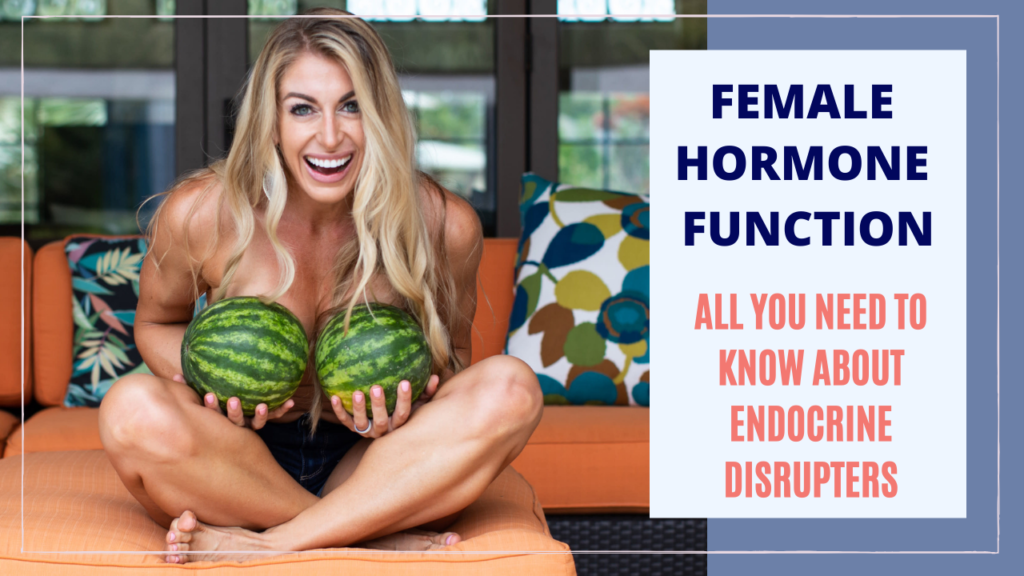
FEMALE HORMONE FUNCTION: Protecting Hormone Balance By Avoiding Endocrine Disruptors
In this blog post, you will learn
- What Endocrine Disruptors do to our hormones
- Where EDs are found + how to avoid them
- Safe-Swaps to consider
When we’re out of balance we experience mood swings, bloating, low mood, cravings, period pain, headaches, hot flashes, night sweats, constipation, and that random inconvenient acne explosion to top it off!
We’re no longer in a day and age where we can blindly accept that what is on the shelf or online available for purchase is SAFE.
What we put on our skin, absorbs into our bloodstream in approximately 28 seconds!
Think of a friend you may know that uses TOPICAL hormone replacement. Directions on the bottle instruct to apply a ‘pea-sized’ amount on your skin daily. That tiny amount of compound changes the ENTIRE way their body functions.
Yet you might be blindly slathering your body with endocrine disruptors daily without your knowledge or consent.
The Endocrine system consists of glands that release hormones that travel around the body until binding to a target receptor. (think lock and key) Once connected they cause a predictable change.
Endocrine disruptors (EDs) MIMIC naturally occurring hormones and block the receptor causing the REAL hormone to never get connected! (think someone else’s key fit your home lock first, and now you can’t get in)
The problem is, the ED’s once connected to the receptor, carry out an entirely DIFFERENT message to the body!
ED’s mainly mimic and block these hormones:
- estrogen (the ‘let’s get it on’ hormone)
- androgen (confidence and firework orgasms hormone)
- Thyroid (feel good and look good hormone)
Endocrine Disruptors are very small but can pack quite a punch even in tiny levels and because of this, they’re measured in parts per trillion.
WHERE ARE ENDOCRINE DISRUPTORS FOUND?
The facts are, with Industry comes chemicals. Top ‘DIRTY DOZEN’ chemicals to be concerned with are:
- Flame Retardants
- Dioxins
- Phytoestrogens
- Pesticides
- Perfluorinated Chemicals
- Phthalates
- BPA (bisphenol A)
- Chemical UV Filters
- Triclosan
- Perchlorate
- Parabens
- BHA & BHT
This means EDs can be found in:
- Food & Food Packaging
- Plastics
- Personal care products
- Cosmetics
- Pharmaceuticals
- Pesticides
- Plastics
- Water
- Dirt
- Home Textiles
Disgustingly, there isn’t a U.S. law that addresses or governs Endocrine Disruptors under an organized system.
There IS an Endocrine Disruptor Screening Program (EDSP) that is currently sifting through approximately 87,000 chemicals. However, at this current time, the EDSP still doesn’t have the authority to regulate any of these chemicals.
Good News: It’s believed that EDs have a cumulative effect. Every effort you make to prevent exposure adds up!
LV’s Suggestion:
Start with the things that make direct contact IN and ON your body. A schedule to ‘ditch the toxins and switch to safer’ may look like this:
- ASAP: Invest in safe sunscreen for the summer.
- APRIL: Consider a Berkey water System
- MAY: Personal care items, bath soaps, shampoos, body lotions, and cosmetics as they run out.
- JUNE: Kitchen items like drinking cups and plastic Tupperware to glass. Frying pans to cast iron, etc.
- JULY: Laundry detergent, fabric softeners, plug-in home air fresheners.
- AUGUST: Check into your local Farmers Markets for Organic Produce
Continue to develop your list as desired.
Add THINK DIRTY APP to your phone. It is a fantastic resource to look up items and scan barcodes prior to purchase and learn about their safety.
Small changes make a huge impact on keeping healthy hormones balanced!
I’ve built out a ‘kit’ of the healthy things I USE & LOVE as a resource for you to use and share.
LV's KIT

